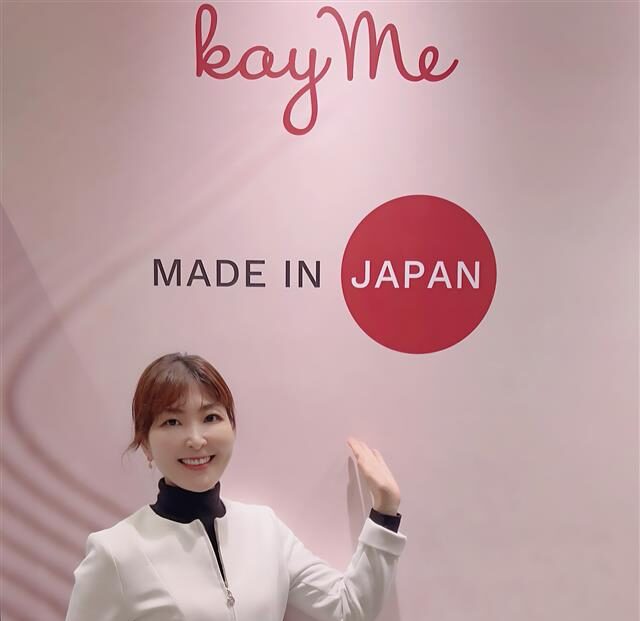From Handshakes to Dashboards: A Leader’s Guide to B2B Sales Transformation
Jocelyn goodjob
on
November 26, 2025
Written by: Kemi Junko
I. Driving Innovation Within Resistant External and Internal Environments
When I founded kay me in 2011, I was determined to create functional, refined clothing options that didn’t exist at the time, while simultaneously preserving Japan’s renowned textile industry and proud craftsmanship, inspired by my grandparents, who ran a traditional kimono shop in Osaka.
Since the beginning, it has been challenging to find the right artisans who could sew fine gathers and drapes using stretch threads for both the stretch outer and lining fabrics – a technique unfamiliar even to the artisans themselves. Though I was inexperienced in garment manufacturing, I focused on turning market needs into reality. For garments and techniques that had never been attempted, I collaborated with material suppliers and sewing and dyeing artisans to turn the ‘impossible’ into reality. In the process, I learned their methods, developing deep respect for their professionalism and a shared commitment to quality and craftsmanship.
Japanese domestic garment production has fallen from nearly 100% before the war to 3% at the time of kay me’s founding and has further declined to about 1% today due to factory closures during the COVID-19 pandemic. This decline reflects not only an economic loss but also a fading of national skill and pride. To me, innovation and preservation are inseparable.
At kay me, we work closely with Japanese artisans to merge tradition with technology. We select innovative fabrics that are stretchy, machine-washable, and wrinkle-resistant, but apply traditional techniques to them. For example, our original prints are produced with Kyoto-based Yuzen dyers, embodying the precision and artistry of Japanese craftsmanship.
We are currently collaborating with local authorities to help preserve and pass on the craftsmanship of ‘Oshima Tsumugi’, a traditional Japanese textile from Amami Oshima and one of the world’s three most renowned fabrics.
Our mission is not only to empower professional women but also to sustain Japan’s textile and manufacturing heritage by maintaining 100% made in Japan production. Building mutual trust in a resistant environment requires both patience and purpose—the belief that together, we can honour tradition while shaping what comes next.
kay me’s strength lies in the analytical thinking I developed while working at an American management consulting firm, where rationality and efficiency were rigorously pursued. Even today, we approach every decision by working backwards from our goal and relying on data-driven insights. This allows us to move quickly without sacrificing quality.
In our early days, a small founding team of two, my sister and I, managed everything, from design and material sourcing to PR, sales, and customer service, often funding apparel development through consulting revenue. This taught me how to balance speed with precision: we launch rapidly where possible but ensure each garment meets the meticulous standards of made-in-Japan craftsmanship.
Leadership at kay me means combining analytical rigour with respect for the artisanal process. It’s about knowing when to accelerate, when to focus, and fostering a culture that values both speed and excellence.
This approach enabled us to expand internationally with speed. From the early days, we established a legal entity in the UK and held a two-month pop-up in Mayfair, while also launching a global e-commerce site capable of direct sales.
Today, we operate three online stores: global, Singapore, and Japan, and five physical stores in Japan: Tokyo Ginza Flagship Store, Tokyo Nihonbashi Store, Tokyo Yurakucho Store, Kyoto Store, and Osaka Umeda Store. After the pandemic, we launched in Singapore at Takashimaya Department Store in November 2024 and in Hong Kong at SOGO Causeway Bay in June 2025.
By combining customer empathy with curiosity and a proactive, solution-oriented approach, employees demonstrate genuine buy-in and actively drive meaningful change
II. Why Change Initiatives are Measured Through Key Human Metrics
At kay me, maintaining a positive, solution-oriented mindset, even in difficult situations, is essential. Employees are expected to approach challenges constructively, focusing on how something can be done rather than dwelling on problems or expressing dissatisfaction.
Genuine commitment is reflected in observable behaviours: how team members engage with customers, gather and reflect on feedback, and their dedication to ensuring no voice or nuance is overlooked.
By combining customer empathy with curiosity and a proactive, solution-oriented approach, employees demonstrate genuine buy-in and actively drive meaningful change. This embodies the culture and values of kay me.
III. Woving Empathy Into Problem-Solving Garners Genuine Employee Buy-In
We cultivate a culture where motivated employees, regardless of gender, nationality, age, or industry background, are encouraged to speak up and bring their ideas to life.
Speaking up and challenging the status quo to create new paths are highly regarded. We also provide flexible work arrangements and leverage a global team skilled in AI and data science to constantly improve efficiency, allowing anyone with potential to contribute fully, even with time constraints.
Meetings at our Japan headquarters are conducted in English to ensure that talented individuals from any country can thrive, regardless of their proficiency in Japanese.
Our team embraces new initiatives with a shared understanding of the company’s vision. Rather than requiring persuasion, commitment is expressed through proactive contributions: employees suggest ideas, take ownership of projects, and refine their approaches based on feedback. This human-centric philosophy guides our product development.
We consistently offer clothing that saves busy professional women time while ensuring comfort. Recently, we launched a new wellness-focused series called ‘Yui’, designed to promote blood circulation and support women fatigued from work. This was developed from this same team-driven, problem-solving mindset.
At kay me, team members across our global operations, from our Japan headquarters to retail stores in each country, including temporary staff, submit daily reports each evening. I personally review nearly all of them on my mobile device to ensure that operations are running smoothly and that no significant issues have arisen.
At the Monday morning meeting, key members from production planning, marketing, technology, store operations, and customer experience review the previous week’s reports in both Japanese and English. We also leverage AI tools to identify issues that require action and provide quick, data-driven guidance. If employees ever feel anxious, it is usually because they cannot take pride in what they deliver to customers or sense uncertainty from them. This process, therefore, also serves as a way to maximise the value we provide to customers through our team. This practice was inspired by my first career in the sales division of Benesse, a major educational publisher; all sales reports were analysed daily by multiple headquarters teams to enable fast responses and continuous improvement. Although our team is multinational, communication remains close. Through our internal chat app, many employees share their honest thoughts and ideas directly with me – something I truly value and appreciate.
Rather than requiring persuasion, commitment is expressed through proactive contributions: employees suggest ideas, take ownership of projects, and refine their approaches based on feedback.
IV. Cultivate Change from the Ground Up and Scaled Into Major Organisation Shifts
The analytical mindset from my BCG training continues to anchor my leadership. At the same time, as a marketer, I place great importance on listening to those around me and turning their feedback into meaningful improvements. Our primary customers include lawyers, doctors, accountants, business owners, and professionals in the fields of IT, finance, and pharmaceuticals.
Through interactions at our stores, customer events, and everyday conversations, I regularly hear about their career and life challenges, how kay me supports them, and areas where we can improve. Additionally, daily reports from our retail teams and quantitative data allow us to understand their true and unmet needs.
Coming from an American management consulting background, I often encountered surprising and sometimes unfamiliar perspectives from individuals in the retail and fashion industries. Initially, I focused on compromise and adaptation. However, as our organisation grew and I engaged with people with diverse values, I realised that progress is fastest when team members share our core philosophy, principles, and strategic mindset. This insight helped us clearly define our hiring approach. Today, across all departments, we collaborate with colleagues who take pride in what makes kay me unique and joined the company because they resonate with our vision.
Coming from a background outside of fashion design and having worked in marketing consulting, I have always embraced the value of uncertainty by engaging directly with the market and our customers. For example, before developing new products, we conduct customer research to forecast demand, enabling efficient production that also supports sustainability. Every decision is grounded in quantifiable evidence, like survey results, sales data, and customer feedback, allowing us to balance empathy for our customers with measurable outcomes.
At kay me, many of our signature services, including ‘try & buy’ and the vision of a full-wardrobe ecosystem, were born directly from the voices of our customers and frontline teams. We treat feedback as a living asset, not a one-time input. Every day, our staff reports, in-store conversations, online comments, and service interactions are captured and reviewed so even the smallest insights are not lost.
We continue to run customer surveys today, both before production and throughout the customer journey, to understand real needs with precision. Our customer support team also plays a critical role. They listen deeply and now use AI tools to help analyse emerging pain points and patterns more quickly. The technology helps us spot themes, but every response back to customers is written by people because personalisation, empathy, and timely care are central to who we are.
Once we identify an opportunity, we act fast: we prototype, test on a small scale, and expand only when we see genuine value for customers. This bottom-up approach ensures that our biggest innovations grow from real experiences in our stores and community, keeping kay me closely aligned with our mission of supporting those who take on challenges.
My grandmother’s words: “life is not about what you obtain, but what you can do for others”, have never been a slogan for me, they were the rhythm of her days. As a child watching her in the small kimono shop, I saw how one person’s devotion could lift another person’s spirit. The quiet joy on customers’ faces as they left her shop is the same joy I hope kay me brings into the world. That memory has been my compass from day one. That belief became kay me’s north star, especially during moments of complex transformation. When we entered international markets, built new product lines, or questioned whether to grow faster or grow truer, we always returned to that single question: Does this decision help someone move forward with more confidence, comfort, and dignity?
The goal is to make people’s lives easier, lighter, and more hopeful. That is why our innovation is always human-led, from creating clothes that save thousands of hours of women’s time, to preserving the skills of Japanese artisans so their craft lives on for future generations, to designing services that remove friction from everyday life.
Every strategic decision is filtered through contribution: are we adding value to people’s lives, or simply adding noise?
As we expand globally, we do not chase scale for its own sake. We grow only where our purpose can make a meaningful difference. Whether it is supporting a professional woman navigating her daily battles, sustaining local craft communities who rely on us, or nurturing a workplace culture where accountability and compassion coexist, every part of our ecosystem must reflect that core philosophy.
In that sense, kay me’s transformation is not about becoming bigger. It is about becoming deeper – more aligned with humanity, more committed to care, and more faithful to the belief my grandmother lived by.
Our mission remains unchanged, no matter how the world evolves: to create comfort, empower confidence, honour craftsmanship, and use innovation to serve people – not replace them. This is how we build a brand not only for today, but for the next 300 years.

Junko founded kay me in March 2011 in Ginza, Tokyo, following the establishment of her own marketing consulting firm in 2008, where she served as CEO. Before her entrepreneurship, she worked at Boston Consulting Group (BCG) from 2004 to 2007, providing strategic consulting services primarily to clients in the finance, IT, and energy sectors. Earlier in her career, she contributed to organisational and HR consulting at PricewaterhouseCoopers (PwC) and began her professional journey in marketing and sales at Benesse Corporation, a leading educational publisher.






